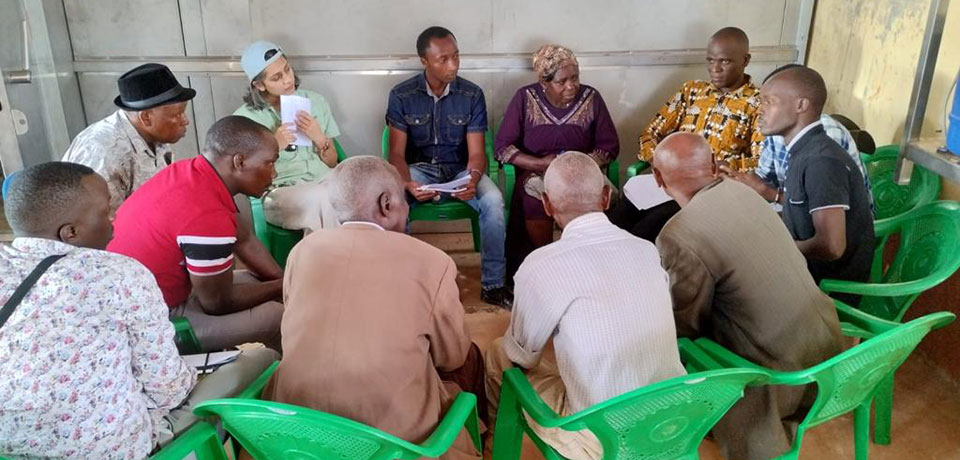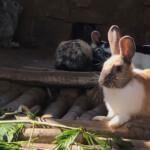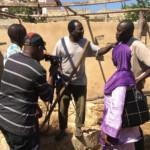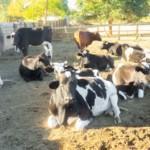
Ivan Oruka, Susma Sharma Khanal, Nathan Roy Akwatampora, Omori Ogutu, Ouma Erick Odongo, Owuor Calvin Obondo & Nina V. Nygrén
Globally, bananas (Musa spp.) rank among the top most consumed fruits, making them not only a critical food security crop but also a day-to-day source of livelihood (FAO, 2020, 2021; Thuo et al., 2017; Voora et al., 2020). For instance, in Africa, approximately over 1,000 varieties (Thuo et al., 2017; Voora et al., 2023) are grown in the tropical zones, Kenya inclusive (Hunt & Fedynich, 2019; Kairu, 2020; Wahome et al., 2021). Here, the main growing areas are Nyanza and Western provinces, accounting for 64.4% (Qaim, 1999) while Central and Eastern provinces account for 26.6% (Njuguna et al., 2010). This crop is predominantly grown by smallholder farmers for home consumption, local markets, and export (Hunt & Fedynich, 2019; Kairu, 2020; Voora et al., 2023; Wahome et al., 2021).
However, these farmers face a myriad of challenges, such as pests and diseases (Kabunga et al., 2011), low yields (Arslan et al., 2016; Wahome et al., 2021), slow and non-uniform growth (Kairu, 2020; Kikulwe, 2016; Thuo et al., 2017) and limited access to clean planting materials (FAO, 2020; Hunt & Fedynich, 2019; Voora et al., 2020). In response to this predicament, the Kenya Agricultural and Livestock Research Organization (KALRO), together with the Jomo Kenyatta University of Agriculture and Technology (JKUAT), have been producing and promoting the adoption of pathogen-free banana cultivars since 1997 (Qaim, 1999). These are early maturing, high yielding, and uniformity in growth (Dubois et al., 2013; Kabunga et al., 2011; Thuo et al., 2017; Wahome et al., 2021).
However, farmers are still growing using sucker-propagated banana (SPB) method, which involves selecting an appropriate sucker from an existing banana plant, defoliating the sucker and removing it from its “mother” (Bhende & Kurien, 2001) as opposed to use of the tissue-cultured banana (TCB) method which involves culturing of any part of plant under sterile and controlled conditions such as those in the laboratory (Gupta et al., 2021). Moreover, evidence from Kenya by Bandewar et al. (2017) and Nthukuri et al. (2021) show that of the 74,000 hectares of the total arable predominantly used by smallholder farmers who are the majority in banana cultivation, only a meager 7% is currently farmed with tissue culture bananas. Existing studies from Kenya have highlighted limited access to information as a major driver of this trend (Irungu et al., 2015; Yigezu, 2021).
The low usage and accessibility of support infrastructures such as electricity, smartphones, computers, internet, social media, online applications, and digital platforms exacerbate the plight (Nthukuri et al., 2021). Furthermore, the majority of studies in Kenya on TCB adoption have concentrated on assessing the impacts of TCB on livelihoods (Kairu, 2020; Qaim, 1999), perceptions and attitudes of farmers towards TCB (Kairu, 2020; Thuo et al., 2017), and disease management on TCB varieties as drivers of adoption (Arslan et al, 2016; Dubois et al., 2013; Thuo et al., 2017) while less attention has been given to the role of information and telecommunication technology (ICT) (Davis, 2004; Simon et al., 2014).
Thus, the AgriScale project student challenge that took place in October 2023 at JKUAT main campus harnessed a close collaboration between the academic sector, corporate partners, and societal actors while focusing on one cooperative to shed more light on the most effective channels of disseminating information about the banana tissue culture value chain in Central Kenya. Specifically, our group sought 1) to find out the socio-economic demographics of the farmers, 2) to identify farmers’ sources of TCB information, and 3) to assess farmers’ constraints to ICT usage in the TCB value chain.
Data collection
The student challenge data was collected from Kandara sub-county, Muranga County, in Central Kenya. Observation, interviews, focus group discussions, and questionnaires were employed in the study. Gikama Saving, Credit and Co-operative Society were purposively selected as they are involved in TCB cultivation. The co-operative society had 24 farmers, all of whom were interviewed.
Results and discussions
Of our interviewees, 70% were male, while 30% were female, and the average age was 58. The majority of the interviewed farmers were married, with an average family size of 6–7 members. 35% of the farmers had completed tertiary education, while 50% had attended primary education, and 15% had received secondary education. These low literacy levels significantly affect access, interpretation, use, and uptake of these various ICT technologies in the form of social media, online applications, and even the ability to use smartphones (Irungu et al., 2015; Nthukuri et al., 2021).
All the farmers interviewed had access to electricity, but 83% had no access to social media platforms, with 75% relying on broadcast media, especially radio. Furthermore, farmers reported obtaining most of their information from government agencies like JKUAT, and KALRO (31%), community-based organizations (CBOs) like co-operatives and other farmers (16%), and non-governmental organizations (11%). All the interviewees also mentioned that accessing information in the local language through broadcast media like Kamene Fm and Inooro TV made it easily understood (Bandewar et al., 2017; Irungu et al., 2015; Nthukuri et al., 2021).
Also, 71% of the interviewed farmers had no access to smartphones and did not know how to use them. 79% of the farmers told us that they spent a very small amount of money (less than 50 Kenya shillings (kshs)) on airtime, and even that money was mainly used for making phone calls. 60% of farmers had no timely access to information about agriculture, and 67% were unsatisfied with their source information. There was a negative correlation between the level of education and the use of ICT technologies. Also, the age of the farmers was negatively correlated with the use of ICT technologies.
Recommendations
We recommend that more young people should be involved in the TCB value chain since they are often more ICT literate, and the majority also own smartphones (Kairu, 2020; Thuo et al., 2017; Wahome et al., 2021). Also, more women should be encouraged to join the TCB value chain, as the majority of them are highly involved in household food production activities.
We recommend producing/participating in radio talk shows specific to the TCB value chain, extending from the current seasonal talk shows to weekly talk shows, as these currently provide more coverage and reliable, timely information to the farmers. We also recommend more extension officers who are experts on the TCB value chain, perhaps one officer per sub-county to two officers or more to reduce farmer to extension officer ratio. Well-designed posters in the local language illustrating the various agronomic practices in the TCB value chain should be made more available to the farmers as these provide them with self-learning.
Lastly, together with other stakeholders, the government should not only subsidize the costs of support services like electricity and internet but also offer incentives to enhance farmers’ ability to purchase, learn, and utilize ICT technologies.
Authors
Ivan Oruka is a student (M.Sc.) in Environmental Science and Natural Resource Management at Gulu University, Uganda.
Susma Sharma Khanal is a student (B.Sc.) in Climate Smart Agriculture at Häme University of Applied Sciences, Finland.
Nathan Roy Akwatampora is a student (B.Sc.) in Agriculture and Community Development at Bishop Stuart University, Uganda.
Omori Ogutu is a student (M.Sc.) in Crop Protection at Egerton University, Kenya.
Ouma Erick Odongo is a student (M.Sc.) in Agricultural and Applied Economics at Jomo Kenyatta University of Agriculture and Technology, Kenya.
Owuor Calvin Obondo is a student (M.Sc.) in Environmental Management and Legislation at Jomo Kenyatta University of Agriculture and Technology, Kenya.
Nina V. Nygren, Dr. Sc. (admin), works as a Senior Lecturer at Häme University of Applied Sciences, Finland.
References
Bandewar, S. V. S., Wambugu, F., Richardson, E., & Lavery, J. V. (2017). The role of community engagement in the adoption of new agricultural biotechnologies by farmers: The case of the Africa harvest tissue-culture banana in Kenya. BMC Biotechnology, 17(1), 1–11. https://doi.org/10.1186/s12896-017-0347-4
Dubois, T., Dusabe, Y., Lule, M., Van Asten, P., Coyne, D., Hobayo, J. C., Nkurunziza, S., Ouma, E., Kabunga, N., Qaim, M., Kahangi, E., Mwirigi, P., Mwaura, P., Kisii, D., Kizito, H., & Mugisha, J. (2013). Tissue culture banana (musa spp.) for smallholder farmers: Lessons learnt from East Africa. Acta Horticulturae, 986, 51–60. https://doi.org/10.17660/actahortic.2013.986.3
FAO. (2020). Medium-term Outlook: Prospects for global production and trade in bananas and tropical fruits 2019 – 2028. Food and Agriculture Organization of the United Nations. https://openknowledge.fao.org/server/api/core/bitstreams/e9805f1a-929b-4e10-a951-1ddaf73fed6d/content
FAO. (2021). Agricultural production statistics 2000–2021. FAOSTAT Analytical Brief 60. https://doi.org/10.4060/cc3751en
Irungu, K. R. G., Mbugua, D., & Muia, J. (2015). Information and Communication Technologies (ICTs) Attract Youth into Profitable Agriculture in Kenya. East African Agricultural and Forestry Journal, 81(1), 24–33. https://doi.org/10.1080/00128325.2015.1040645
Kabunga, N. S., Dubois, T., & Qaim, M. (2011). Information Asymmetries and Technology Adoption: The Case of Tissue Culture Bananas in Kenya. Discussion Papers, 74. Georg-August-Universität Göttingen, Courant Research Centre – Poverty, Equity and Growth. https://hdl.handle.net/10419/90476
Kairu, E. K. (2020). The Influence of agricultural innovative strategies on banana productivity among smallholder farmers in Kirinyaga County, Kenya [Master’s Thesis, Strathmore University]. http://hdl.handle.net/11071/10178
Kikulwe, E. (2016). Banana tissue culture: community nurseries for African farmers. In J. Andrade-Piedra, J. Bentley, C. Almekinders, K. Jacobsen, S. Walsh, & G. Thiele (Eds.), Case Studies of Roots, Tubers and Bananas Seed Systems (pp. 180–196). RTB Working Paper 2016-3. RTB Program Management Unit, International Potato Center (CIP). https://cgspace.cgiar.org/bitstream/handle/10568/82709/Kikulwe_2016_RTB_WP.pdf
Kathuri, D. N., Ndirangu, S. N., & Gichimu, B. (2021). Adoption of Banana (Musa spp) Production Technology among Small-Scale Farmers in Embu West Sub-County, Kenya. Journal of Agricultural Extension, 25(4), 109–118. https://doi.org/10.4314/jae.v25i4.12
Qaim, M. (1999). Assessing the Impact of Banana Biotechnology in Kenya [ISAAA Briefs, 10]. ISAAA. https://www.isaaa.org/resources/Publications/briefs/10/download/isaaa-brief-10-1999.pdf
Thuo, C. N., Nguluu, S., & Kisangau, P. (2017). Factors Affecting Adoption of Tissue Culture Bananas in the Semi-Arid Areas of Lower Eastern Region of Kenya. International Journal of Recent Research in Life Sciences, 4(3), 1–26. http://repository.seku.ac.ke/handle/123456789/3563
Voora, V., Bermudez, S., Farrell, J. J., Larrea, C., & Luna, E. (2023). Global market report: Banana prices and sustainability. Sustainable Commodities Marketplace Series. IISD. https://www.iisd.org/publications/report/global-market-report-banana
Voora, V., Larrea, C., & Bermudez, S. (2020). Global Market Report: Bananas. Sustainable Commodities Marketplace Series. IISD. https://www.iisd.org/system/files/publications/ssi-global-market-report-banana.pdf
Wahome, C. N., Maingi, J. M., Ombori, O., Kimiti, J. M., & Njeru, E. M. (2021). Banana Production Trends, Cultivar Diversity, and Tissue Culture Technologies Uptake in Kenya. International Journal of Agronomy, 2021. https://doi.org/10.1155/2021/6634046
Yigezu, M. (2021). Digitalization in teaching and education in Ethiopia. Background report. ILO. https://researchrepository.ilo.org/esploro/outputs/report/Digitalization-in-teaching-and-education-in/995218732102676





